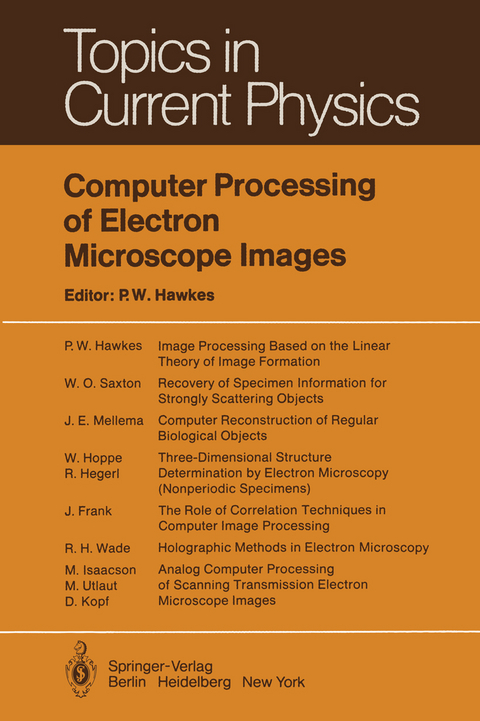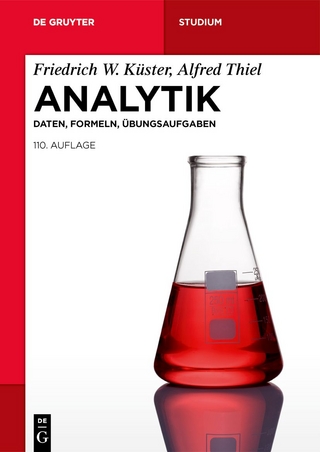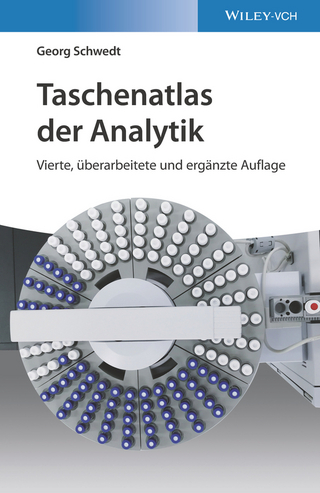
Computer Processing of Electron Microscope Images
Springer Berlin (Verlag)
978-3-642-81383-2 (ISBN)
1. Image Processing Based on the Linear Theory of Image Formation.- 1.1 Transfer Functions.- 1.2 Transfer Functions with Partially Coherent Illumination.- 1.3 Practical Exploitation of the Linear Relationship.- References.- 2. Recovery of Specimen Information for Strongly Scattering Objects.- 2.1 Image Formation and Interpretation.- 2.2 Methods Iterating the Linear Theory Solution.- 2.3 Methods Requiring No Special Apertures.- 2.4 Methods Using Half-Plane Apertures.- 2.5 Analytic Wave Functions and Complex Zeros.- 2.6 Holography.- 2.7 Ptychography and Related Methods.- 2.8 Bright-Field/Dark-Field Subtraction.- 2.9 Other Perspectives.- 2.10 Conclusions.- References.- 3. Computer Reconstruction of Regular Biological Objects.- 3.1 The Biological Object.- 3.2 Fourier Processing of Electron Micrographs.- 3.3 Recent Applications to Image Processing of Regular Biological Structure.- 3.4. Outlook.- References.- 4. Three-Dimensional Structure Determination by Electron Microscopy (Nonperiodic Specimens).- 4.1 History and General Discussion of the Subject.- 4.2 The Fundamental Theoretical Background.- 4.3 The Problem of Reconstruction.- 4.4 Aspects for the Future.- References.- 5. The Role of Correlation Techniques in Computer Image Processing.- 5.1 Correlation Functions.- 5.2 Computation.- 5.3 Some Important Theorems.- 5.4 Determination of Relative Positions.- 5.5 Matched Filtering.- 5.6 Characterization of Instrument Conditions.- 5.7 Signal-to-Noise Ratio Measurement.- 5.8 Conclusions.- References.- 6. Holographic Methods in Electron Microscopy.- 6.1 Historical Background.- 6.2 Holographic Schemes.- 6.3 Experimental Electron Holography.- 6.4 Contrast Transfer and Holography.- 6.5 Additional Reading.- 6.6 Conclusions.- References.- 7. Analog Computer Processing of Scanning Transmission Electron Microscope Images.- 7.1 Organization.- 7.2 Characteristics of Analog Processing.- 7.3 Types of Signals Available in the STEM.- 7.4 Instrumental Characteristics.- 7.5 Applications.- 7.6 Conclusion.- References.- Appendix: Publication Details of International and European Congresses on Electron Microscopy.- Additional References with Titles.
| Erscheint lt. Verlag | 27.12.2011 |
|---|---|
| Reihe/Serie | Topics in Current Physics |
| Co-Autor | J. Frank, P.W. Hawkes, R. Hegerl, W. Hoppe, M.S. Isaacson, D. Kopf, J.E. Mellema, W.O. Saxton, M. Utlaut, R.H. Wade |
| Zusatzinfo | XIV, 296 p. |
| Verlagsort | Berlin |
| Sprache | englisch |
| Maße | 170 x 244 mm |
| Gewicht | 547 g |
| Themenwelt | Naturwissenschaften ► Chemie ► Analytische Chemie |
| Naturwissenschaften ► Physik / Astronomie ► Atom- / Kern- / Molekularphysik | |
| Naturwissenschaften ► Physik / Astronomie ► Festkörperphysik | |
| Schlagworte | Bildverarbeitung • Complexity • Computer • Electron Microscope • Elektronenmikroskopie • Natur • Optics |
| ISBN-10 | 3-642-81383-6 / 3642813836 |
| ISBN-13 | 978-3-642-81383-2 / 9783642813832 |
| Zustand | Neuware |
| Informationen gemäß Produktsicherheitsverordnung (GPSR) | |
| Haben Sie eine Frage zum Produkt? |
aus dem Bereich


